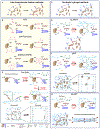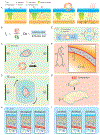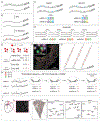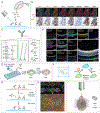Basic principles of hydrogel-based tissue transformation technologies and their applications
- PMID: 34358468
- PMCID: PMC8372535
- DOI: 10.1016/j.cell.2021.07.009
Basic principles of hydrogel-based tissue transformation technologies and their applications
Abstract
Emerging tissue transformation technologies provide an unprecedented opportunity to investigate system-level molecular and anatomical features in situ. Hydrogel-based methods engineer physicochemical tissue properties to render intact organs optically transparent and size and shape adjustable while preserving biomolecules at their physiological locations. When combined with advanced molecular tools, labeling, and imaging techniques, tissue transformation enables three-dimensional (3D) mapping of molecules, cells, and their interrelationships at increasing speeds and resolutions. In this review, we discuss the basic engineering principles of tissue transformation and labeling techniques as well as their broad applications, current challenges, and future potential.
Copyright © 2021 Elsevier Inc. All rights reserved.
Conflict of interest statement
Declaration of interests The authors declare no competing interests.
Figures








Similar articles
-
Three-Dimensional Printing and Injectable Conductive Hydrogels for Tissue Engineering Application.Tissue Eng Part B Rev. 2019 Oct;25(5):398-411. doi: 10.1089/ten.TEB.2019.0100. Epub 2019 Sep 11. Tissue Eng Part B Rev. 2019. PMID: 31115274 Review.
-
Double network hydrogel for tissue engineering.Wiley Interdiscip Rev Nanomed Nanobiotechnol. 2018 Nov;10(6):e1520. doi: 10.1002/wnan.1520. Epub 2018 Apr 17. Wiley Interdiscip Rev Nanomed Nanobiotechnol. 2018. PMID: 29664220 Review.
-
Microfluidic hydrogels for tissue engineering.Biofabrication. 2011 Mar;3(1):012001. doi: 10.1088/1758-5082/3/1/012001. Epub 2011 Mar 4. Biofabrication. 2011. PMID: 21372342 Review.
-
3D printing of electrically conductive hydrogels for tissue engineering and biosensors - A review.Acta Biomater. 2020 Jan 1;101:1-13. doi: 10.1016/j.actbio.2019.08.044. Epub 2019 Aug 30. Acta Biomater. 2020. PMID: 31476385 Review.
-
Micro-injection molded, poly(vinyl alcohol)-calcium salt templates for precise customization of 3D hydrogel internal architecture.Acta Biomater. 2019 Sep 1;95:258-268. doi: 10.1016/j.actbio.2019.04.050. Epub 2019 Apr 24. Acta Biomater. 2019. PMID: 31028908
Cited by
-
Functional Hydrogels for Treatment of Chronic Wounds.Gels. 2022 Feb 17;8(2):127. doi: 10.3390/gels8020127. Gels. 2022. PMID: 35200508 Free PMC article. Review.
-
Research trends in cardiovascular tissue engineering from 1992 to 2022: a bibliometric analysis.Front Cardiovasc Med. 2023 Aug 1;10:1208227. doi: 10.3389/fcvm.2023.1208227. eCollection 2023. Front Cardiovasc Med. 2023. PMID: 37593146 Free PMC article.
-
Strongly absorbing molecules make tissue transparent: a new insight for understanding tissue optical clearing.Light Sci Appl. 2025 Jan 1;14(1):10. doi: 10.1038/s41377-024-01675-z. Light Sci Appl. 2025. PMID: 39741136 Free PMC article.
-
3D visualization of uterus and ovary: tissue clearing techniques and biomedical applications.Front Bioeng Biotechnol. 2025 Jul 7;13:1610539. doi: 10.3389/fbioe.2025.1610539. eCollection 2025. Front Bioeng Biotechnol. 2025. PMID: 40692613 Free PMC article. Review.
-
In situ identification of cellular drug targets in mammalian tissue.Cell. 2022 May 12;185(10):1793-1805.e17. doi: 10.1016/j.cell.2022.03.040. Epub 2022 Apr 27. Cell. 2022. PMID: 35483372 Free PMC article.
References
-
- Alon S, Goodwin DR, Sinha A, Wassie AT, Chen F, Daugharthy ER, Bando Y, Kajita A, Xue AG, Marrett K, Prior R, Cui Y, Payne AC, Yao CC, Suk HJ, Wang R, Yu CC, Tillberg P, Reginato P, … Boyden ES (2021). Expansion sequencing: Spatially precise in situ transcriptomics in intact biological systems. Science, 371(6528). 10.1126/science.aax2656 - DOI - PMC - PubMed
-
- Bolin FP, Preuss LE, Taylor RC, & Ference RJ (1989). Refractive index of some mammalian tissues using a fiber optic cladding method. 28(12), 2297–2303. - PubMed
Publication types
MeSH terms
Substances
Grants and funding
LinkOut - more resources
Full Text Sources
Other Literature Sources

